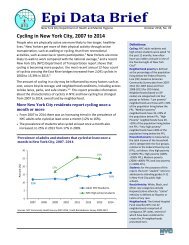2013-dot-sustainable-streets-lowres
2013-dot-sustainable-streets-lowres
2013-dot-sustainable-streets-lowres
Create successful ePaper yourself
Turn your PDF publications into a flip-book with our unique Google optimized e-Paper software.
MOBILITYChapter 7Streets for All:Improving Choices for Short Trips365miles of new bikelanes since 2007New York City is ideally suited to walking and cycling. Thecity’s dense design means many trips are short. Of auto tripsin New York, 10% are under one–half mile, 22% are underone mile and 56% are under three miles—distances thatcan easily be covered on foot or on a bike. Shifting even asmall number of these trips to bicycles or walking results insignificant benefits.Cycling and walking have clear health and environmentalbenefits, and also create broad mobility gains. Makingcycling viable and walking more attractive adds choice tothe transportation menu, and can dramatically increase theutility and flexibility of public transportation for city dwellers.PlaNYC and Sustainable Streets laid out clear goals forbringing cycling into the transportation mainstream. Avery strong emphasis on public health, traffic safety andan improved public realm by the Bloomberg Administrationalso put the pedestrian at the center of transportation and<strong>streets</strong>cape planning, constituting a comprehensive pro–walking strategy for the entire city.New York City has made dramatic strides in creatingmodern, safe <strong>streets</strong> that are attractive for cycling andwalking. At the core of this progress are programs tooverhaul the design of <strong>streets</strong> so they are more balancedand inviting for all users. This work re–made dangerousintersections, opened new walking routes, helpedpedestrians and cyclists orient themselves and createda cycling network that connects the city. Since 2007,NYCDOT has created over 350 miles of bike lanes andlaunched the largest and most heavily–used bike sharesystem in the Western Hemisphere. To address a furtherbarrier to bicycle transportation, DOT has added 16,000bicycle parking racks to City <strong>streets</strong>, and begun to transform12,000 old parking meter poles into additional bike parking.With the City Council, DOT defined and enacted a ground–breaking office building bike parking program that DOTadministers.CAR JOURNEY LENGTHS, NYC10% 10% 12% 15% 19%34%LESS THAN.5 MILES3–5 MILES.5–1 MILEMORE THAN10 MILES5–10 MILES1–3 MILESThe results have been staggering. Cycling has become muchsafer and attractive for people of all ages. The city reachedits Sustainable Streets goal of doubling DOT bike counts oncommuter routes from 2007 to 2012 in 2011, a year early.Until recently few children and older adults were seen ridingbikes in New York. Now bike paths and protected bike lanesare enjoyed by families and cyclists of all ages and abilities.As described in depth in the Safety Section, there was a73% decrease in the average risk of a serious injury whilebicycling in New York between 2001 and 2011.New plazas, pedestrian wayfinding maps, publicseating and the broad range of safety and traffic calmingimprovements described in the chapters above on publicsafety have provided a broad improvement in the spaceand safety afforded to pedestrians. Innovative projects likeBroadway Boulevard/Greenlight for Midtown, 6.5 Avenueand the remake of <strong>streets</strong> around Brooklyn’s Grand ArmyPlaza have made walking routes more direct, generated newfoot trips and improved safety.Sustainable Streets: <strong>2013</strong> and Beyond83



